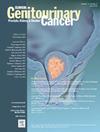卡介苗-谷氨酰胺-无反应的高风险非肌肉浸润性膀胱癌患者的现实世界治疗模式和结果:多国医疗图表回顾
IF 2.7
3区 医学
Q3 ONCOLOGY
引用次数: 0
摘要
卡介苗(BCG)无反应的高危非肌浸润性膀胱癌(NMIBC)患者不适合或拒绝根治性膀胱切除术(RC)的治疗模式报道不一致。我们回顾性地描述了这些患者的人口学、临床和治疗特征,并评估了他们的临床结果。患者和方法回顾了2011年1月1日至2018年12月31日期间15个学术中心记录的不符合或拒绝RC的bcg无反应高风险NMIBC(原位癌[队列A]或T1/高级别Ta[队列B])患者的病历。主要目的是描述人口学、临床和非手术治疗特征。次要目标包括评估肌肉侵袭性/转移性疾病的真实无进展生存期(rw-PFS)、恶化等级或分期的真实无进展生存期(rw-PFS)、队列A的真实完全缓解率(rw-CRR)、队列B中高风险NMIBC的真实无事件生存期(rw-EFS)和总生存期。结果本研究纳入129例患者(A组,n = 57;队列B, n = 72)。中位年龄为72.0岁(四分位数范围为64.0-80.0)。大多数患者为男性(72.1%)和当前/曾经吸烟者(69.8%)。中位随访时间为32.1个月(四分位数间距为20.7-47.6)。卡介苗再挑战加或不加干扰素-α(63.6%)是最常用的非手术治疗方法,其次是膀胱内丝裂霉素C加或不加电动机药物或热化疗(15.5%)和膀胱内valrubicin (10.9%);在单独接受卡介苗再挑战的患者中,54.8%的患者在≥2次后续治疗中接受了非卡介苗治疗。来自肌肉侵袭性/转移性疾病的rw-PFS的36个月生存率为73.5%,来自恶化等级/分期的rw-PFS为66.8%,总生存率为82.5%。在队列A中,6个月rw-CRR为22.2%。在队列B中,高风险NMIBC的36个月rw-EFS发生率为50.2%。结论高危NMIBC患者在发生卡介苗无应答性疾病后,多数接受了卡介苗再攻,且有或无其他治疗;25%的患者在前3年内出现疾病进展。对于无bcg反应的NMIBC,需要有效的保膀胱方案。临床试验注册本文章由计算机程序翻译,如有差异,请以英文原文为准。
Real-World Treatment Patterns and Outcomes in Patients With Bacillus Calmette-Guérin–Unresponsive High-Risk Non–Muscle-Invasive Bladder Cancer: A Multicountry Medical Chart Review
Introduction
Treatment patterns for patients with bacillus Calmette-Guérin (BCG)–unresponsive high-risk non–muscle-invasive bladder cancer (NMIBC) who are ineligible for or decline radical cystectomy (RC) are inconsistently reported. We retrospectively described demographic, clinical, and treatment characteristics for these patients and assessed their clinical outcomes.
Patients and Methods
Medical charts of patients with BCG-unresponsive high-risk NMIBC (carcinoma in situ [cohort A] or T1/high-grade Ta [cohort B]) who were ineligible for or declined RC documented between January 1, 2011, and December 31, 2018, at 15 academic centers were reviewed. Primary objectives were to characterize demographic, clinical, and nonsurgical treatment characteristics. Secondary objectives included assessing real-world progression-free survival (rw-PFS) from muscle-invasive/metastatic disease, rw-PFS from worsening grade or stage, real-world complete response rate (rw-CRR) in cohort A, real-world event-free survival (rw-EFS) from high-risk NMIBC in cohort B, and overall survival.
Results
The study included 129 patients (cohort A, n = 57; cohort B, n = 72). Median age was 72.0 years (interquartile range, 64.0-80.0). Most patients were male (72.1%) and current/former smokers (69.8%). Median follow-up was 32.1 months (interquartile range, 20.7-47.6). BCG rechallenge with or without interferon-α (63.6%) was the most commonly utilized first nonsurgical therapy, followed by intravesical mitomycin C with or without electromotive drug administration or thermochemotherapy (15.5%), and intravesical valrubicin (10.9%); among those who received BCG rechallenge alone, 54.8% later received a non-BCG therapy in ≥ 2 subsequent treatments. 36-month rate for rw-PFS from muscle-invasive/metastatic disease was 73.5%, 66.8% for rw-PFS from worsening grade/stage, and 82.5% for overall survival. In cohort A, 6-month rw-CRR was 22.2%. In cohort B, 36-month rw-EFS rate from high-risk NMIBC was 50.2%.
Conclusion
After BCG-unresponsive disease, most patients with high-risk NMIBC received BCG rechallenge with or without other therapies, and > 25% experienced disease progression within the first 3 years. Effective bladder-sparing options for BCG-unresponsive NMIBC are needed.
Clinical trial registration
N/A.
求助全文
通过发布文献求助,成功后即可免费获取论文全文。
去求助
来源期刊

Clinical genitourinary cancer
医学-泌尿学与肾脏学
CiteScore
5.20
自引率
6.20%
发文量
201
审稿时长
54 days
期刊介绍:
Clinical Genitourinary Cancer is a peer-reviewed journal that publishes original articles describing various aspects of clinical and translational research in genitourinary cancers. Clinical Genitourinary Cancer is devoted to articles on detection, diagnosis, prevention, and treatment of genitourinary cancers. The main emphasis is on recent scientific developments in all areas related to genitourinary malignancies. Specific areas of interest include clinical research and mechanistic approaches; drug sensitivity and resistance; gene and antisense therapy; pathology, markers, and prognostic indicators; chemoprevention strategies; multimodality therapy; and integration of various approaches.
 求助内容:
求助内容: 应助结果提醒方式:
应助结果提醒方式:


